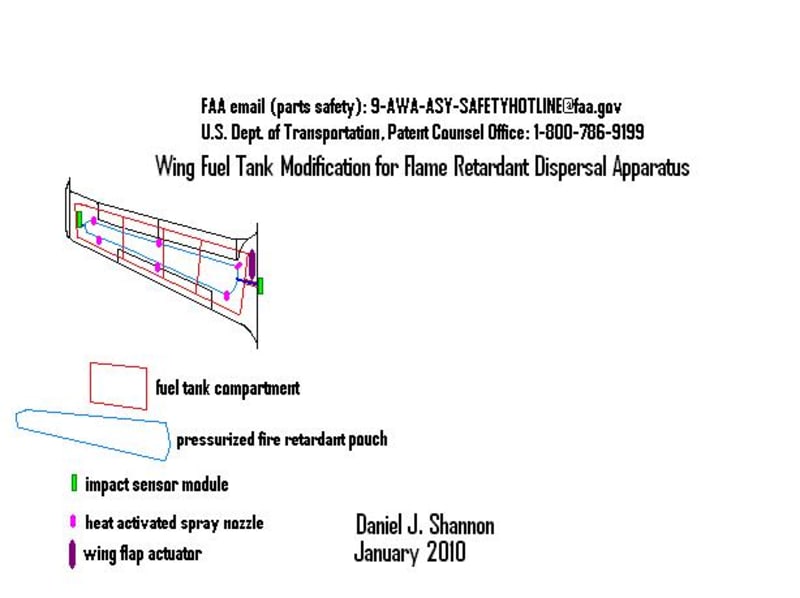January 4, 2010
Proposed Airplane Fuel Tank Modification
The basic concept for the modification is a series of pressurized rectangular pouches of blastproof acrylic fabric, such as Kevlar, which are affixed (epoxied?) to the top and bottom outer surfaces of the plane’s wing fuel tanks, as well as on the central fuel tank in the bottom center of the fuselage.
The pouches contain dry powder AFFF-UL flame retardant and a chemical propellant to initiate a rapid chain reactive gas (CO2) expansion, activating dispersal of the chemical through flap actuator-triggered automated nozzles on the pouches in the event of a measured crash impact. Each pouch is wired to two battery-powered electronic impact sensors, one sensor at the base of the wing, the other at the wingtip. The central tank would have impact sensors on its front and rear bases, and on the underside surface. When the impact sensors, through G-force measurement, detect a crash impact has occurred, electrodes in the sensors send electric current to the nozzles, opening them and dispersing the flame retardant. As the retardant powder makes contact with the heated air / flames produced by the ignited fuel, the retardant powder releases gases (CO2 ?) which act as an oxygen barrier to the fire, and it self-extinguishes relatively rapidly enough to prevent potential more severe burn injuries to passengers and flight crew. Toxic smoke fumes are also diluted (and diminished?) in this process, and lung injury potential is lessened.
Multi-passenger commercial and private aircraft produced by manufacturers Boeing, Rockwell, Cessna, Beechcraft, and Learjet would be the primary aircraft to have their fuel tanks retrofitted with the pouches at scheduled intervals as directed by the Federal Aviation Administration and the National Transportation Safety Board. At a future timeframe military transport, bomber, and fighter craft would be modified to have the pouches in their wing tanks. It should be noted that the pouches likely would slightly alter the gross weight of each modified aircraft, and it is currently unknown if any alteration of internal wing structures is needed for the pouch installation.
The production and installation costs for the pouches is also yet to be determined.
Like this entry?
-
About the Entrant
- Name:Daniel Shannon
- Type of entry:individual
- Hardware used for this entry:Dell Dimension 2400Software used for this entry:Microsoft Paint 5.1, MS Word
- Patent status:none

